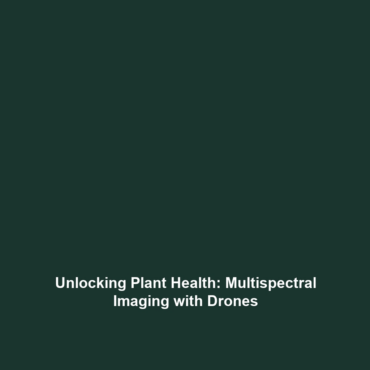Multispectral Imaging to Detect Plant Stress and Nutrient Levels
Introduction
Multispectral imaging has emerged as a pivotal technique in the realm of drones in science, particularly for the detection of plant stress and nutrient levels. This technology captures data across various wavelengths of light, enabling researchers and farmers to assess the health of crops efficiently. With the increasing need for sustainable agricultural practices, utilizing drones equipped with multispectral sensors is becoming essential. By identifying stress markers in plants early on, stakeholders can make informed decisions, ultimately leading to improved crop yields and resource management.
Key Concepts
Fundamentals of Multispectral Imaging
Multispectral imaging involves collecting data from different segments of the electromagnetic spectrum. This technique provides valuable insights into a plant’s physiological status by analyzing light reflected from leaves and soil. In the context of drones in science, this method allows for:
- Enhanced understanding of plant health.
- Early detection of nutrient deficiencies.
- Real-time data collection over large agricultural areas.
Applications and Real-World Uses
The integration of multispectral imaging with drones has spurred numerous applications, enhancing agricultural practices. Some notable examples include:
- Crop Monitoring: Drones equipped with multispectral cameras can survey fields and provide detailed maps indicating areas of stress or nutrient deficiency.
- Precision Agriculture: Farmers can optimize irrigation and fertilization based on the data gathered, leading to more efficient resource use.
- Research and Development: Scientists use this technology to study plant responses to environmental changes in real time.
Current Challenges
Despite its advantages, there are several challenges associated with using multispectral imaging for detecting plant stress:
- High Initial Costs: The expense of drones and advanced imaging equipment can be prohibitive for some farmers.
- Data Processing: Analyzing the large volumes of data generated can require significant computational resources and expertise.
- Environmental Factors: Variables such as weather conditions and topography can affect image quality and interpretation.
Future Research and Innovations
The future of multispectral imaging and drones in science looks promising. Innovations on the horizon include:
- Integration with Artificial Intelligence: Automated systems capable of identifying plant stress through machine learning models.
- Development of Lighter Sensors: Technological advancements aimed at creating more efficient cameras for drones, enhancing flight time and data collection accuracy.
- Improved Data Analytics: Software aimed at simplifying data interpretation, making it accessible to non-experts.
Conclusion
In summary, multispectral imaging is playing a crucial role in detecting plant stress and nutrient levels, significantly enhancing the field of drones in science. As technology evolves, the potential for greater agricultural efficiency becomes evident. Stakeholders are encouraged to explore these innovative tools to foster sustainability in agriculture. For further insights into related technologies, consider reading our articles on Agricultural Technology and Drone Applications in Science.

